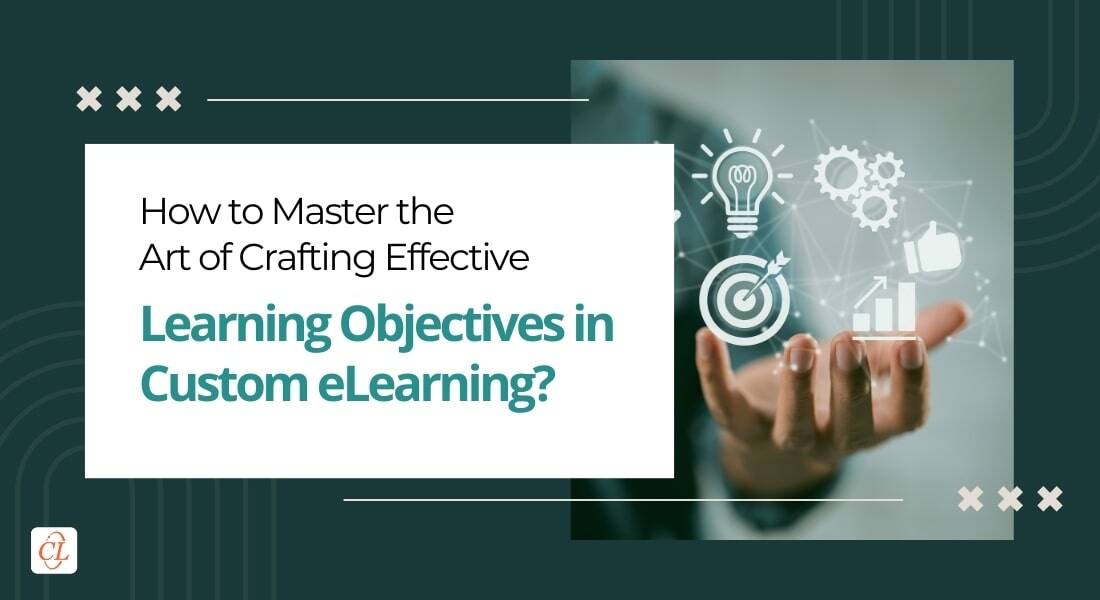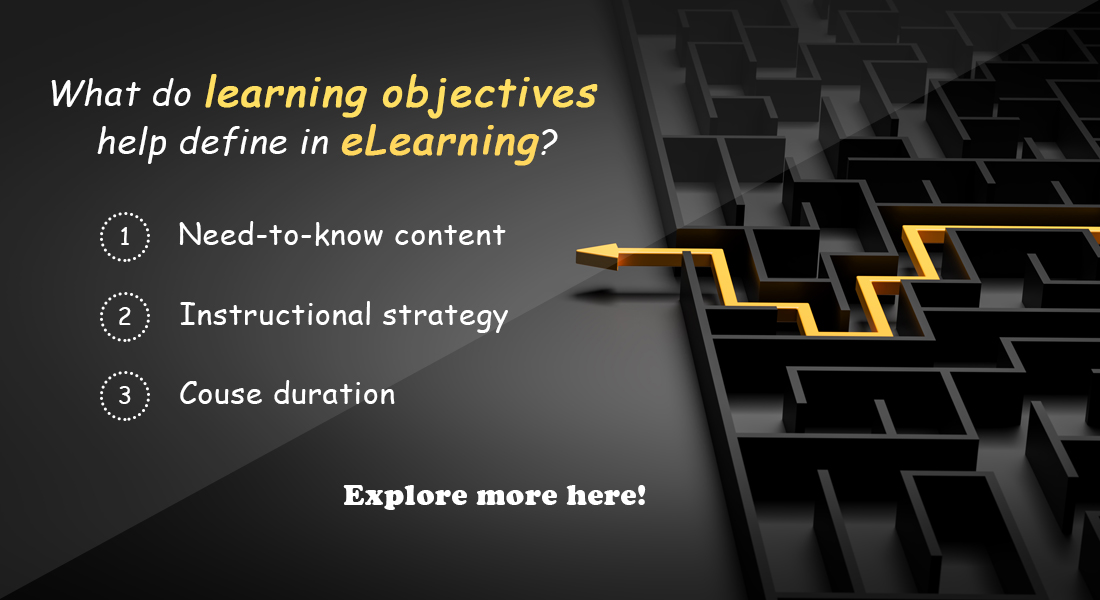How to Craft Winning Learning Objectives for Custom eLearning Courses

In Stephen Covey's The 7 Habits of Highly Effective People, he emphasizes the importance of “starting with the end in mind.” This philosophy applies perfectly to custom eLearning course development. Clearly defined learning objectives are the foundation for a successful course, ensuring both learners and instructors are on the same page. Custom eLearning allows you to tailor the learning experience to your specific audience's needs. But before you dive into content creation, it's crucial to define what you want learners to achieve by the end of the course. This is where well-crafted learning objectives come in.
→ Download Now: How To Use ChatGPT — A Guide for Instructional Designers
Table of Contents
- What are Learning Objectives?
- Why are Clear Learning Objectives Important in Custom eLearning?
- What are the Essential Attributes of Learning Objectives?
- How to Craft Clear Learning Objectives for Custom eLearning Courses?
What are Learning Objectives?
A learning objective is a measurable statement that describes what a learner will be able to do after completing a specific eLearning course. It outlines the knowledge and skills they will gain. In the context of custom eLearning, the learning objectives should be specific to the unique learning requirements of the employees and must be aligned with the goals of your business. This will help you ensure a high-impact custom eLearning program.
Why are Learning Objectives Important for Custom eLearning?

Learning objectives serve several vital purposes in custom eLearning. A few of them are listed below:
- Guide Learner Focus: Clear learning objectives provide a roadmap for learners, keeping them focused on the “big picture” and the desired outcomes of the course.
- Facilitate Self-Assessment: Well-defined objectives allow learners to gauge their progress and understanding throughout the course.
- Streamline Course Design and Development: Learning objectives act as a blueprint for the course structure, ensuring that the training content aligns with the intended learning outcomes.
- Help Measure Training Effectiveness: According to Gallup’s State of the Global Workplace report, highly engaged workplaces see significant benefits—17% higher productivity, 20% more sales, and 21% greater profitability compared to disengaged ones. The key to driving this engagement? Aligning eLearning assessments with clear learning objectives. When your custom eLearning program is designed to measure success effectively, it can play a pivotal role in building a more engaged and high-performing workforce.

How to Use ChatGPT — A Guide for Instructional Designers
Create Immersive Learning Experiences by leveraging ChatGPT
- Frame Learning Objectives
- Generate Scenarios
- Design Assessments
- And More!
What are the Essential Attributes of Learning Objectives?
Let us now look into some characteristics of learning objectives that will enable an instructional designer to frame learning objectives efficiently for custom eLearning courses.
1. Simple
The learning objective must be simple and brief. Learners have to immediately understand their learning outcomes. An instructional designer must avoid using long paragraphs and complicated words. The goals must also be realistic and achievable. For example, “Explain the importance of eLearning” is simpler than “Comprehensibly rationalize the importance of eLearning.”
2. Grounded
Before framing appropriate learning objectives, instructional designers must find answers to a few questions, such as:
- What are the learners supposed to learn?
- What is the learner’s prior knowledge and skill on the content or topic?
- What are the learners’ preferred styles of learning?
Answering these questions will help the instructional designers understand their learners and frame the learning objectives accordingly. This can be well understood by this scenario.
A student once asked their teacher to explain the right angle. Instead of giving a simple explanation, the teacher started discussing advanced concepts that were beyond the student’s level. This left the student confused because they weren't ready for that level of detail. A simpler explanation, like comparing a right angle to the shape of the letter 'L,' would have been more effective. This example highlights the importance of understanding students' prior knowledge before creating learning objectives.
3. Intent and Performance Specific
The learning objectives of a custom eLearning course should clearly specify the intent of the course and what it is expected to achieve. There should not be any space for misinterpretation. A relevant verb can be selected from Bloom’s Taxonomy to describe the required behavior of the objective.
Learning objectives should also specify performance. In other words, it should specify or state what learners are expected to do after the course completion. A very important point to be noted is that each and every learner taking up the course should be able to do something new and better than before.
Also, ensure that the learning objectives are framed correctly. For example, if you are going to teach learners about the parts of a machine and you frame the learning objective as, “By the end of this program, learners will be able to operate a machine”, then this will confuse the learners as their learning objective is only to learn the parts of the machine.
4. Aligned to Assessment
eLearning assessments must be created in alignment with the learning objectives and content. If the learners have completed the assessments successfully, it means that they have achieved the learning objectives.
If you are teaching your learners how to calculate Body Mass Index (BMI) and ask them questions like “Which country has the heaviest children in Asia?”, then it would be illogical as your main motive was to ensure that the learners understand how to calculate BMI and not mandatorily know which country had the heaviest children in Asia. The effectiveness of any learning objective can be known only by assessing learners on it.
Discover how to design effective assessments that align perfectly with your learning objectives in this video!
How to Craft Clear Learning Objectives for Winning Custom eLearning Courses?
Want to Craft Clear Learning Objectives for Effective Custom eLearning Courses?
Here are the 5 important things to remember:
- Avoid Abstract or Unclear Statements
- Set Clear Performance Goals
- Don’t Misinterpret Performance Conditions
- Focus on Learners’ Performance
- Ensure Emphasis on Learning Outcomes, Not Teaching Methodology
Here are the 5 things to keep in mind to ensure relevant, impactful learning objectives for your custom eLearning courses.
1. Avoid Abstract or Unclear Statements:
It's important to remember that while designing custom eLearning courses, the learning objectives should be written in simple, concise language that is easily understood by the target audience. Avoid jargon or overly complex wording that can lead to confusion.
For example:
Instead of saying "Have a profound awareness and comprehensive knowledge of..." which is abstract, say "Be able to explain the key principles of..." which is clear and actionable.
2. Set Clear Performance Goals:
Having clear performance goals and an effective performance management system is crucial when learning something new! Therefore, it’s important to set SMART goals for your custom eLearning program.

Your learning objectives should clearly convey exactly what you want the learner to do, how to do, and the final outcome that they should be able to achieve after they've finished the course. If the performance objective is unclear or incorrect, it might not describe the course goals accurately.
Here’s an example:
Unclear Goal: “Be able to think critically about safety precautions...”
Clear, Measurable Performance Goal: “Be able to identify and implement three essential safety protocols...”
3. Don’t Misinterpret Performance Conditions:
Avoid any confusion in the learning outcomes of your custom eLearning development. To do so, specify the performance conditions under which learners should apply the acquired skills and how they should do so. This will help you understand if they understand the real-world applications of the concept and will be able to execute it successfully.
Example:
Confusing Condition Statement: “The learner will be able to troubleshoot equipment malfunctions…”
Well-Phrased, Clear Statement: “Given a malfunctioning piece of equipment and a user manual, the learner will be able to troubleshoot and diagnose the problem...”
4. Focus on Learners’ Performance:
The objectives of your custom eLearning courses should focus on learner outcomes – what the learner will achieve, not what the instructor will do.
Here’s an example:
“The instructor will provide learners with exposure to various product assembly tasks…”
This statement focuses on what the instructor will do. Instead, you can write, “After completing the course on product training, learners will be able to independently assemble the product using the provided instructions.”

How to Use ChatGPT — A Guide for Instructional Designers
Create Immersive Learning Experiences by leveraging ChatGPT
- Frame Learning Objectives
- Generate Scenarios
- Design Assessments
- And More!
5. Ensure Emphasis on Learning Outcomes, Not Teaching Methodology:
Learning objectives for custom eLearning development should focus on the outcomes rather than that of process or procedure. They should describe the learning outcomes, not the teaching methods by focusing on “what” learners will achieve, not “how” the instructor will deliver the content.
So avoid using, “The course will utilize interactive simulations to teach learners about…” Instead, you can use, “Upon completion, learners will be able to demonstrate proficiency in…”
Parting Thoughts!
By incorporating clear and well-defined learning objectives, you can ensure your custom eLearning course is effective, engaging, and delivers the desired results for both learners and instructors. Remember, custom eLearning is all about tailoring the experience to your audience's needs. Start with the end in mind, define your learning objectives, and create a course that empowers your learners to achieve their goals.
Do you know that you can use AI for instructional design and various course development tasks? That’s right! You can even use it to craft relevant, clear learning objectives. Wondering how? Check out our free guide below!





![7 Quick Tips to Frame Effective Learning Objectives for Custom eLearning [Infographic]](https://blog.commlabindia.com/hubfs/blogs/tips-frame-effective-learning-objectives.jpg)